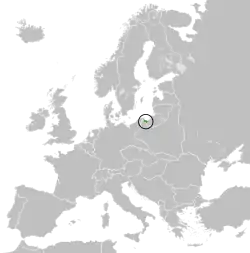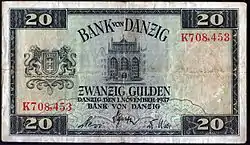Free City of Danzig
The Free City of Danzig (German: Freie Stadt Danzig; Polish: Wolne Miasto Gdańsk) was a self-governing port on the Baltic Sea port and a city-state. It was set up on January 10, 1920, by Part III Section XI of the Treaty of Versailles of 1919, and put under League of Nations protection, with special rights reserved to Poland,[1] because it was the only port in the Polish Corridor.
Free City of Danzig | |||||||||
|---|---|---|---|---|---|---|---|---|---|
| 1920–1939 | |||||||||
 Flag
 Coat of arms
| |||||||||
| Motto: "Nec Temere, Nec Timide" | |||||||||
| Anthem: Für Danzig / Gdańsku | |||||||||
 Danzig, surrounded by Germany and Poland | |||||||||
 Location of the Free City of Danzig in 1930s Europe | |||||||||
| Status | Free City under League of Nations protection | ||||||||
| Capital | Danzig | ||||||||
| Common languages | |||||||||
| Religion | |||||||||
| Government | Republic | ||||||||
| High Commissioner | |||||||||
• 1919–1920 | Reginald Tower | ||||||||
• 1937–1939 | Carl Jacob Burckhardt | ||||||||
| Senate President | |||||||||
• 1920–1931 | Heinrich Sahm | ||||||||
• 1934–1939 | Arthur Greiser | ||||||||
| Legislature | Volkstag | ||||||||
| Historical era | Interwar period | ||||||||
• Independence from Germany | 15 November 1920 | ||||||||
| 1 September 1939 | |||||||||
• Annexed by Germany | 2 September 1939 | ||||||||
| Area | |||||||||
| 1923 | 1,966 km2 (759 sq mi) | ||||||||
| Population | |||||||||
• 1923 | 366730 | ||||||||
| Currency |
| ||||||||
| |||||||||
| Today part of | |||||||||
The Free City ceased to exist after 1939 when it was occupied and annexed by Nazi Germany. After Germany's defeat in 1945 Danzig was occupied and annexed by Poland under the Polish name Gdańsk.
Establishment
Territory
The Free City of Danzig included the major city of Danzig (Gdańsk) as well as Zoppot (Sopot), Tiegenhof (Nowy Dwór Gdański), Neuteich (Nowy Staw) and some 252 villages and 63 hamlets. Its area was 1,966 km2 (759.1 sq mi).
Polish rights
The Free City was represented abroad by Poland's ambassadors. The railway line that connected the Free City with Poland was administered by Poland. Similarly, the separated military post within the city's harbour, the Westerplatte (formerly a city beach), was also given to Poland. There were also two post-offices, one for the Danzig Postal Service, the other was Polish-run.
League of Nations High Commissioners
League of Nations mandated territories, were run by member countries on behalf of the League. But Danzig and the Saargebiet were run by the League of Nations itself, with representatives of various countries taking on the role of High Commissioner:[2]
| Name | Period | Country | |
|---|---|---|---|
| 1 | Reginald Thomas Tower | 1919-1920 | |
| 2 | Edward Lisle Strutt | 1920 | |
| 3 | Bernardo Attolico | 1920 | |
| 4 | Richard Cyril Byrne Haking | 1921-1923 | |
| 5 | Mervyn Sorley McDonnell | 1923-1925 | |
| 6 | Joost Adriaan van Hamel | 1925-1929 | |
| 7 | Manfredi di Gravina | 1929-1932 | |
| 8 | Helmer Rosting | 1932-1934 | |
| 9 | Seán Lester | 1934-1936 | |
| 10 | Carl Jakob Burckhardt | 1937-1939 |

Population
The Free City's population was 357,000 in (1919). 98% were German-speakers,[3] with the rest mainly speaking either Kashubian or Polish.
The Treaty of Versailles, split Danzig from Germany. The treaty made the people living in the city citizens of the Free City. German inhabitants lost their German nationality, if they wanted to stay German they had to go and live outside the Free City's territory.[1]
Politics
Heads of State of the Free City of Danzig[2]
| Presidents of the Danzig senate | Took Office | Left Office | Party | |
|---|---|---|---|---|
| 1 | Heinrich Sahm | 6 December 1920 | 10 January 1931 | none |
| 2 | Ernst Ziehm | 10 January 1931 | 20 June 1933 | DNVP |
| 3 | Hermann Rauschning | 20 June 1933 | 23 November 1934 | NSDAP |
| 4 | Arthur Karl Greiser | 23 November 1934 | 23 August 1939 | NSDAP |
| State President | ||||
| 5 | Albert Förster | 23 August 1939 | 1 September 1939 | NSDAP |
In May 1933, the Nazi Party won the local elections in the city. But they had less than the two-thirds majority that would let them change the Constitution of the Free City of Danzig. The government introduced anti-Semitic and also anti-Catholic laws against the Poles and Kashubian inhabitants.
Poland always refused to allow the status of Danzig to change. In April 1939 the Polish Commissioner-General said that Poland was willing to fight if there was a change..[4]
Second World War and aftermath
The Nazi government voted for re-unification with Germany on September 2, 1939, the day after the German invasion of Poland began.
Around 90% of the city was reduced to ruins towards the end of the Second World War. On March 30, 1945 the city was taken by the USSR. It is thought that more than 90% of the pre-war population were either dead or had fled by 1945.
The Allied Powers were told at the Potsdam conference that the former Free State was now part of Poland. (The Yalta conference was unclear whether the Free City would be recreated or not).
Related pages
- Gdańsk
- Danzig Corridor
References
- Yale Law School. "The Versailles Treaty June 28, 1919 : Part III". The Avalon Project. Archived from the original on 2008-02-14. Retrieved 2007-05-03.
- "Danzig subsection of Poland entry from World Statesmen.org".
- Encyclopaedia Britannica Year Book, 1938
- Woodward, E.L., Butler, Rohan, Orde, Anne, editors, Documents on British Foreign Policy 1919 - 1939, 3rd series, vol.v, HMSO,London, 1952:25
Other websites

- Jewish community history
- History of Gdansk/Danzig
- Gdańsk history Archived 2006-10-07 at the Wayback Machine
- In 1997 Gdansk celebrated his thousand anniversary
- history & hallucination Archived 2007-04-28 at the Wayback Machine
- The power of Gdansk Archived 2007-09-30 at the Wayback Machine